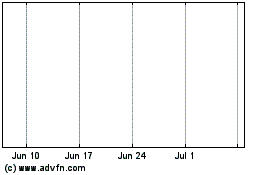By Liz Hoffman
This article is being republished as part of our daily
reproduction of WSJ.com articles that also appeared in the U.S.
print edition of The Wall Street Journal (January 19, 2018).
Morgan Stanley on Thursday reported fourth-quarter results that
highlighted the fruits of Chief Executive James Gorman's efforts to
make the firm a simpler and steadier earner.
Quarterly profit rose 14%, excluding a tax charge, as the firm's
retail brokers and investment bankers compensated for a decline in
trading that has been widely felt across Wall Street.
The firm earned 84 cents a share on revenue of $9.5 billion,
which was up 5% from a year ago. Analysts had expected 77 cents a
share, excluding the impact of a one-time, $990 million charge
related to the new tax law. Net income of $1.7 billion beat analyst
expectations.
Including the tax charge, which was lower than Morgan Stanley
had indicated, the firm earned $686 million, or 29 cents per
share.
Morgan Stanley, the smallest of the big six U.S. banks, was the
last to report earnings for a quarter that was muddied by tax
charges and marked by continued gloom for trading operations and
strength in consumer and investment banking.
Eight years into his tenure, Mr. Gorman has now achieved most of
the numerical targets he set out in early 2016. Morgan Stanley has
cut more than $1 billion in fixed expenses, cleaned up trouble
spots like fixed-income trading, improved the profitability of its
giant retail brokerage, and hit its goal of a 9% return on
equity.
Mr. Gorman's next challenge is to boost that return -- which
measures how well a company invests shareholders' money -- into the
low teens. This is a level that investors typically demand given
the risk that comes with owning bank stocks.
On Thursday, Mr. Gorman set a new goal of 10% to 13% return on
equity, without specifying a time frame. A lower tax rate will
help, as will the roll-off in 2019 of some expensive contracts with
brokers who joined in the acquisition of Smith Barney.
But future gains will likely be tougher than those achieved to
date, as Mr. Gorman has already pulled obvious levers such as
cutting expenses and reducing risky trading assets. What is more,
Morgan Stanley's wealth management and investment banking business
are riding a bull stock market that likely won't last forever.
Quarterly revenues in fixed-income trading, which Morgan Stanley
sharply cut two years ago after repeated blunders, fell 45% in the
quarter. Peers reported declines of between 14% and 50% in that
business as few market catalysts spurred clients to trade.
"Very, very quiet," CFO Jonathan Pruzan said of the quarter. He
said he was "cautiously optimistic" that the backdrop would
improve.
Morgan Stanley held its ground in stock trading, where it is
Wall Street's leader. Revenues rose 2% in that business.
One area of weakness: Merger advisory revenues fell 6%, widening
the deficit between it and Goldman, which on Wednesday posted a 9%
rise in that business to cement its role as Wall Street's top
M&A shop. More than $1.1 billion in trailing-year revenue now
separates them, the widest gap in two years.
Morgan Stanley's X-Factor, though, is increasingly its giant
retail brokerage, which oversees $2.4 trillion for some 3.5 million
households. That unit's revenue rose 10%, while lower expenses
lifted its profit margin -- once in the high single digits -- 1
percentage point to 26%. Mr. Gorman set a new upper goal of
28%.
Broker attrition and hiring, which are both expensive, have
fallen, Mr. Pruzan said. Morgan Stanley and rivals including Bank
of America Corp.'s Merrill Lynch unit and UBS Group AG have
effectively called a truce on a yearslong poaching war, a move that
ruffled some brokers but is likely to reduce costs across the
industry.
Morgan Stanley's retail brokerage gets a growing portion of its
revenue from steady fees that are assessed as a percentage of
client portfolios, rather than commissions on trades. As the stock
market marches higher, Morgan Stanley is guaranteed profits on
those accounts whether clients trade or not.
On 99% of days last year, the brokerage brought in between $50
million and $80 million in revenue. More than three-quarters of
this came from steady sources such as management fees and interest
on client loans.
Morgan Stanley kept a lid on expenses, making good on a 2016
promise to cut $1 billion in costs, assuming flat revenue. Dubbed
Project Streamline, the effort's roughly 200 initiatives included
lowering bankers' and traders' pay, shifting workers to cheaper
locations like Baltimore and combining data centers.
Regulatory changes from Washington, including decreasing the
level of capital banks must hold, could improve returns further by
allowing the firm to increase its dividends or buybacks.
"We think we're overcapitalized by several billion dollars," Mr.
Gorman said. "If we got some change that allowed us to take action
on that, in the absence of finding better ways to invest it or
better things to buy, we believe in being very shareholder friendly
on this stuff."
Write to Liz Hoffman at liz.hoffman@wsj.com
(END) Dow Jones Newswires
January 19, 2018 02:47 ET (07:47 GMT)
Copyright (c) 2018 Dow Jones & Company, Inc.
Morgan Stanley (NYSE:MWD)
Historical Stock Chart
From Mar 2024 to Apr 2024

Morgan Stanley (NYSE:MWD)
Historical Stock Chart
From Apr 2023 to Apr 2024
